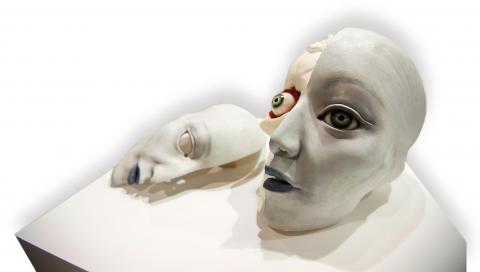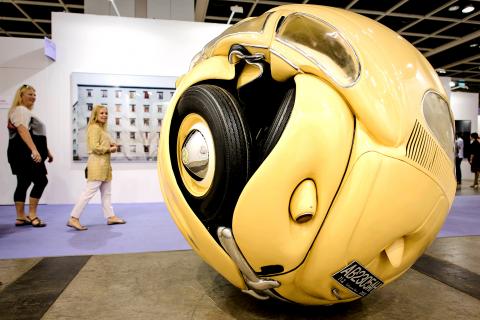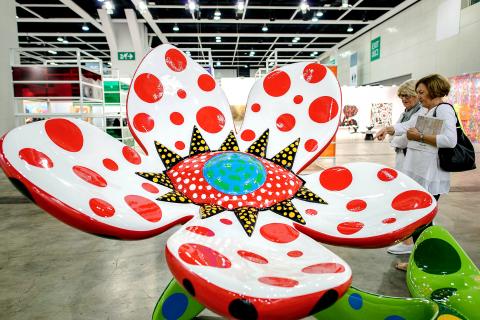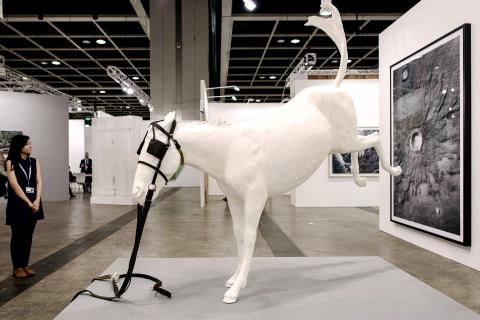Having taken five Volkswagen Beetles and compressed them into spheres, artist Ichwan Noor was always going to grab attention at the inaugural Hong Kong Art Basel.
Noor is known in his native Indonesia but is hoping the glittering, champagne-soaked art fair will give him further recognition beyond his home borders.
Such are the opportunities that await emerging and lesser-known artists at the fair, which aims to highlight Hong Kong’s growing role as a global arts hub.

Photo: EPA
Soon after the event opened to guests on Wednesday, Noor saw one of his US$88,000 Beetle Spheres snapped up.
“Events like Hong Kong Art Basel will provide him (Noor) with the needed exposure,” Jakarta-based art museum and gallery Art:1 deputy director Monica Gunawan, said.
“He is quite well known in Jakarta, but not so much in the international art market.”

Photo: AFP
Works from more than 3,000 international artists have been exhibited through 245 of the world’s leading galleries, more than half of which are from Asia.
Buoyed by the arrival of so many well-heeled international collectors, galleries have competed with each other to hold lavish parties in the hope of attracting big-spending buyers.
At one event earlier this week supermodel Kate Moss was photographed sipping champagne with the likes Rupert Murdoch’s wife Wendi and Dasha Zhukova, the art collecting wife of billionaire Chelsea FC owner Roman Abramovich.

Photo: AFP
Henrietta Tsui, owner of local specialists Gallerie Ora-Ora and founder of the Hong Kong Art Gallery Association, has even taken guests out into Hong Kong’s Victoria Harbor on the family’s 80-foot yacht. She initially planned to hold a single event on the boat but had to make multiple trips because of demand.
“The response has been overwhelming, we were five times oversubscribed and we couldn’t accommodate all of them,” she said, adding that buyers came from all across the globe.
“It’s been fun at the back of the (exhibition) room trying to figure out all the different credit cards from around the world — that’s quite an indication of the kind of turnout,” she said.

Photo: AFP
The four-day annual show, which ended last Sunday, has until now only been held in Switzerland and the United States and has made a dazzling debut in a city better known as a fast-paced financial hub.
Art:1, which is exhibiting in Hong Kong for the first time, is aiming to match up its artists with collectors who show long-term interest, Gunawan said.
“If we can get a good collector from here and maintain a long-term international relationship, it would be very good,” she said.
Collectors new to Hong Kong are looking to tap into the growing Asian market. Gagosian, White Cube, Acquavella, Lehmann Maupin and Galerie Perrotin are just some of the big-name galleries to have arrived in the city in the past two years despite sky-high rents.
Art Basel replaces Art HK, Hong Kong’s former art fair which was set up in 2008. It was recently taken over by the high-profile Swiss Art Basel franchise, which has been showcasing modern and contemporary art since 1970.
The event also featured local Hong Kong artists such as Lam Tung-pang who showcased his One-Two-World, an installation where scale models, plants and drawings were projected on paper.
Also on display were five works including video and three-dimensional installations using day-to-day items by Lam’s compatriot Tang Kwok-hin (鄧國騫).
“I’m here to see if there’s anything new to pick up, maybe Asian artists that I’m not so familiar with or we don’t see as much in Europe or in the States,” said Garance Massart, who directs a Switzerland-based art consultancy.
“You have emerging artists, you have very established impressionists, modern Picassos for multimillion dollar numbers and maybe five stands behind you’ll have a 15,000 euro artist that’s not as famous,” Massart said of the fair’s selection.
With its international status, convenient location as an Asian hub and a large selection of leading galleries compared to other city centers in Asia, “it makes sense” to have the fair in Hong Kong, said Massart.
“I think the wealth is growing and so is the market,” she said.
The former British colony has surged to third place in the global art auction market behind New York and London.
The boom in Hong Kong’s international art market is largely a result of the fast-growing wealth of mainland Chinese, some of whom are investing heavily in art.
There has also been a growing interest among Chinese and Asian collectors for different types of international art aside from traditional works.
“Just seeing the growth in China of the new collectors ... it’s just good that they are starting to open themselves to art,” said Melanie Ouyang Lum, an art consultant based in Los Angeles looking for up and coming works at the fair.
“There’s a lot of Chinese collectors who are going abroad now and going to a lot of the fairs ... and starting to educate themselves about art,” Lum, who has been working extensively with Chinese artists for the past five years, said.
“I think that’s a springboard and they will influence the younger generation,” she said.
With a younger and more affluent generation of Chinese collectors being more involved in the art scene, the Asian art market could become very lucrative, Lum said.
“I think the sky’s the limit.”

The Taipei Times last week reported that the rising share of seniors in the population is reshaping the nation’s housing markets. According to data from the Ministry of the Interior, about 850,000 residences were occupied by elderly people in the first quarter, including 655,000 that housed only one resident. H&B Realty chief researcher Jessica Hsu (徐佳馨), quoted in the article, said that there is rising demand for elderly-friendly housing, including units with elevators, barrier-free layouts and proximity to healthcare services. Hsu and others cited in the article highlighted the changing family residential dynamics, as children no longer live with parents,

It is jarring how differently Taiwan’s politics is portrayed in the international press compared to the local Chinese-language press. Viewed from abroad, Taiwan is seen as a geopolitical hotspot, or “The Most Dangerous Place on Earth,” as the Economist once blazoned across their cover. Meanwhile, tasked with facing down those existential threats, Taiwan’s leaders are dying their hair pink. These include former president Tsai Ing-wen (蔡英文), Vice President Hsiao Bi-khim (蕭美琴) and Kaohsiung Mayor Chen Chi-mai (陳其邁), among others. They are demonstrating what big fans they are of South Korean K-pop sensations Blackpink ahead of their concerts this weekend in Kaohsiung.

Taiwan is one of the world’s greatest per-capita consumers of seafood. Whereas the average human is thought to eat around 20kg of seafood per year, each Taiwanese gets through 27kg to 35kg of ocean delicacies annually, depending on which source you find most credible. Given the ubiquity of dishes like oyster omelet (蚵仔煎) and milkfish soup (虱目魚湯), the higher estimate may well be correct. By global standards, let alone local consumption patterns, I’m not much of a seafood fan. It’s not just a matter of taste, although that’s part of it. What I’ve read about the environmental impact of the

Oct 20 to Oct 26 After a day of fighting, the Japanese Army’s Second Division was resting when a curious delegation of two Scotsmen and 19 Taiwanese approached their camp. It was Oct. 20, 1895, and the troops had reached Taiye Village (太爺庄) in today’s Hunei District (湖內), Kaohsiung, just 10km away from their final target of Tainan. Led by Presbyterian missionaries Thomas Barclay and Duncan Ferguson, the group informed the Japanese that resistance leader Liu Yung-fu (劉永福) had fled to China the previous night, leaving his Black Flag Army fighters behind and the city in chaos. On behalf of the